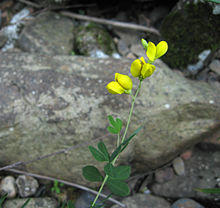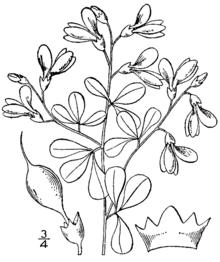| Baptisia tinctoria | |
|---|---|
 | |
| Scientific classification | |
| Kingdom: | Plantae |
| Clade: | Tracheophytes |
| Clade: | Angiosperms |
| Clade: | Eudicots |
| Clade: | Rosids |
| Order: | Fabales |
| Family: | Fabaceae |
| Genus: | Baptisia |
| Species: | B. tinctoria |
| Binomial name | |
| Baptisia tinctoria (L.) R.Br. ex Ait.f. | |
Baptisia tinctoria (common names include yellow false indigo, wild indigo,[1] wild-indigo[2] and horseflyweed[3]) is a herbaceous perennial plant in the family Fabaceae. It is native to eastern North America.
Distribution
Baptisia tinctoria is found throughout the eastern United States, west to Minnesota, and south to Florida.[4] As it is rare in some parts of its range, it is protected by some state authorities: in Kentucky it is threatened; in Maine it is considered endangered.[5] It prefers dry meadow and open woodland environments.[6]
Description
The multiple bushy stems of Baptisia tinctoria reach 2 to 3 feet tall. The leaves are silver-green; each is divided into three leaflets about ½ inch long. The flowers are yellow and grow in spikes 1½ to 3 inches long.[7]
The leaves are eaten by some lepidopteran caterpillars, for example the Io moth (Automeris io).
On Martha's Vineyard, the species is a tumbleweed: it grows in a globular form, breaks off at the root in the autumn, and tumbles about.[1]
References
- ^ a b C. E. Bessey (1886). "The tumble-weed of the west". Botanical Gazette. University of Chicago Press. 11 (2): 41. doi:10.1086/325904. S2CID 85134259.
- ^ "BSBI List 2007". Botanical Society of Britain and Ireland. Archived from the original (xls) on 2015-01-25. Retrieved 2014-10-17.
- ^ "Baptisia tinctoria". Natural Resources Conservation Service PLANTS Database. USDA. Retrieved 9 January 2016.
- ^ Canby, William. "Notes on Baptisia." Botanical Gazette 4 (1879): 129-132.
- ^ USDA, NRCS. 2007. The PLANTS Database (http://plants.usda.gov, 31 May 2007). National Plant Data Center, Baton Rouge, LA 70874-4490 USA.
- ^ "Baptisia tinctoria". Missouri Botanical Garden. http://www.mobot.org/gardeninghelp/plantfinder/Plant.asp?Code=J500 (accessed May 24, 2007).
- ^ Crockett, James U.; Allen, Oliver (1977). "Wildflower Gardening" (1 ed.). Alexandria, Virginia: Time-Life Books.
